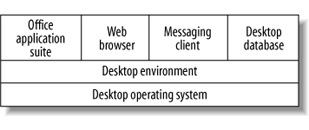Section B.1. Solutions
B.1. SolutionsSolutions for the desktop space work in layers, with solutions at each layer depending on functionality and services from the layer below and providing functionality to the layers above. The key layers of the desktop are shown in Figure B-1. Figure B-1. Layers of desktop functionality We see two main migration scenarios:
B.1.1. Linux DistributionA variety of Linux distribution choices are available for enterprise-wide deployment. The more cutting-edge distributions provide a lower level of support. But several mainstream options also are available, including Red Hat, Mandriva, SuSE, Debian, and Gentoo. The first three are company-supported distributions that come with the option of purchasing support contracts. The last two are community supported, mostly through mailing lists, forums, and chat rooms. When choosing a distribution, you should apply the following criteria:
B.1.2. Desktop EnvironmentDesktop environment refers to the graphical interface where the user does her work. Complete desktop environments consist of a large number of tightly integrated but separate pieces of software. By default, GNOME uses a window manager called Metacity, and KDE uses kwin. The window manager is, of course, the most important part of the desktop. It handles window placement, movement, appearance, and user interaction with all the windows on the desktop. The choice of window manager is probably the most important factor in the success of a Linux migration on desktops. Several window managers are available that offer a wide spectrum of options in the tradeoff between resource use and functionality. Table B-1 illustrates the point. XFCE4 is a less resource-intensive desktop environment. It is also highly customizable.
In examining and evaluating desktop environments, consider the following enterprise-user requirements as paramount:
B.1.3. Productivity SoftwareIn examining productivity software, we confine ourselves to word processing, spreadsheet software, and presentation software, since meaningful alternatives to Microsoft Office exist in these three categories. We consider the following as requirements for enterprise users:
Note that open source productivity software such as Open Office is steadily gaining ground on major proprietary platforms such as Microsoft Windows and Mac OS X. B.1.4. Desktop Database ManagementApplications in this category are alternatives to Microsoft Access, Microsoft FoxPro, and Adobe FileMaker. While local applications using a desktop database are fast becoming a rarity in enterprises, we recognize the continuing need for an alternative to Microsoft Access. Most open source productivity suites provide alternatives to Access by providing a usable interface to existing open source database servers such as MySQL or PostgreSQL. B.1.5. Web BrowsersApplications in this category are alternatives to Microsoft Explorer. The security problems and lack of regular functionality updates in Microsoft Explorer have created an opportunity in this area, and the Mozilla Project has capitalized on it. Mozilla Firefox is a modern, stable, and secure web browser available for all major desktop environments. B.1.6. Messaging ClientSince messaging is a collaboration tool, we provide a detailed explanation of messaging clients in Appendix D. |
- ERP Systems Impact on Organizations
- Enterprise Application Integration: New Solutions for a Solved Problem or a Challenging Research Field?
- A Hybrid Clustering Technique to Improve Patient Data Quality
- Relevance and Micro-Relevance for the Professional as Determinants of IT-Diffusion and IT-Use in Healthcare
- Development of Interactive Web Sites to Enhance Police/Community Relations